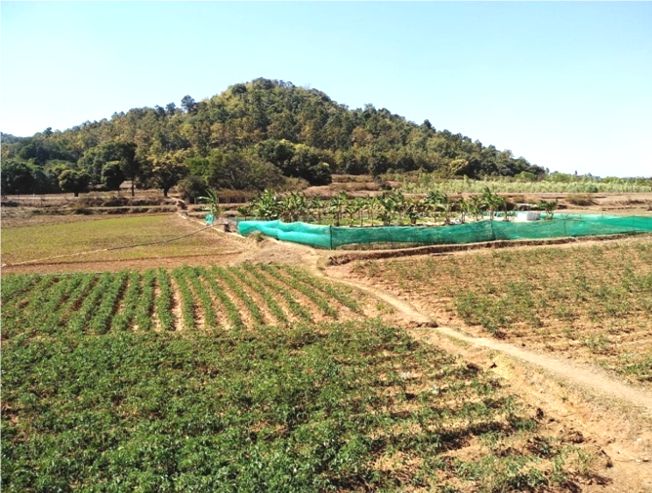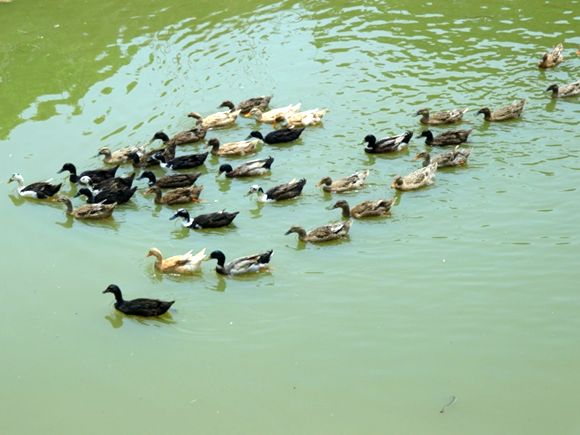
Rapid population growth is leading to land fragmentation and reducing the amount of cultivable land available to owners. This trend of declining land ownership combined with natural disasters is reducing the viability and sustainability of agriculture.
Koraput, dominated by indigenous peoples, is known for its natural resources, i.e., land, soil, vegetation, water, human resources, and animal resources. However, these resources have not been effectively utilized for the economic growth of the farmers. As a result, farming communities remained economically backward and farmers showed no interest in farming and migrated to nearby cities or other states to earn a living.
Therefore, there was a need to develop strategies that would enable higher production, create adequate employment and income generation, and reduce household food insecurity and climate risk, especially for small and marginal farmers.
In this scenario, integrated farming system has proven to be a sustainable and climate-resilient approach to agriculture. M. S. Swaminathan Research Foundation (MSSRF), with the support of Directorate of Agriculture and Food Production, Government of Odisha, under the Rashtriya Krishi Vikas Yojana, has been empowering farmers to adopt the integrated farming system model, which provides a better source of income and livelihood.
Through this model, diversified agricultural components like livestock, poultry, fisheries, duck farming, beekeeping, mushroom and crop components are integrated and make agriculture profitable for holistic improvement of small and marginal farming communities.
Case of a successful farmer who adopted the integrated farming system model
Mr. Mangaraj Khara (52) of Kharagada village in Boipariguda block of Koraput district is a successful farmer of integrated farming system who owns three acres of land (1.5 acres of lowland, 1 acre of middle land and 0.5 acre of highland). He also owns a pond measuring 30 x 20 meters. On these lands, he used to cultivate fish, rice, peanuts, vegetables such as pumpkin and bitter gourd with conventional methods and earned very little.
However, now the place is an attraction for the rural population because it is a unique model for this region that ensures a better income by effectively using the available resources with diversified operations on the same piece of land where farmers normally grow only rice.

The figure above shows that the cost of cultivation is slightly higher in the integrated farming system model than in the conventional method. Nevertheless, the integrated farming system model almost doubles the farmer's total income and net profit, which mitigates the Union government's strategy of doubling the farmer's income.
"I used to have to migrate to nearby towns for livelihood, which kept me away from home. Later, I decided to take up farming to earn an income in the village itself. With my limited land and available resources, I engaged in rice, peanuts and fish farming, but could not make a bigger profit from it,” says Mangaraj Khara, a local farmer.
He learnt the benefits of the integrated farming system model and connected with it. Through it, he was trained in fish farming using a scientific approach and learnt the techniques such as pre, during and after stocking of fish farming.
“After learning the benefits of integrated farming, I renovated my pond and dike area to make the model ideal. I followed a package of practices such as: mud removal, dike cleaning, removal of predatory fish using nets or mahua cakes, maintaining water quality (pH) by applying lime, slurry preparation for plankton development, and so on,” says Mangaraj.

"In the past, the adjacent land remained fallow after the rice was harvested in conventional agriculture. But now, under the integrated farming system, I grow vegetables and pulses such as green gram, black gram by using the pond water after rice harvest. I established a vermicompost pit, prepared bio-inputs and applied it in the field to control pests and diseases and improve soil productivity. This post-rice cultivation improves my income," says Mangaraj.

"I stock mixed yearlings, i.e. Catla, Rahu and Mrigala, to better manage the space and water layer. Using a scientific approach through the integrated farming system, I made a net profit of about Rs. 40,000 last year, and there was still a quarter (approximately) of the fish left in the pond,” says Mangaraj.
“The income from fish farming is three times more than the income I earn from the conventional method. I also chose to breed ducks, which eats the predatory fish and helps the yearlings grow, apart from serving as aerators. The eggs from duck farming are eaten by our children, and the surplus eggs are sold in the village and at the weekly market," he added.
He further said, "I grow fruit-bearing plants such as papaya, banana, lemon, guava, and seasonal vegetables on the pond dike for household consumption, and the surplus produce is sold in the local market, from which I earned about Rs. 15,000 last year."
The way forward
There are still some gaps that need to be addressed to sustain the integrated farming system model, such as timely access to quality fish yearlings and improved fish feed in the region. To buy these, they have to go far away from their village, and have to compromise on quality, and sometimes it is not available. The fruit bearing plants are only available in nurseries at higher prices. Market linkage for fish sales needs to be improved to generate better income.
/articles/successful-model-integrated-farming-system-koraput